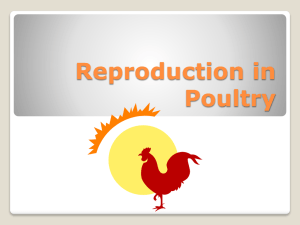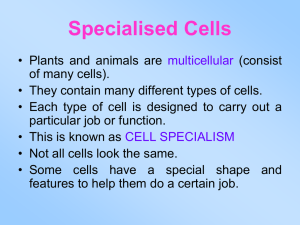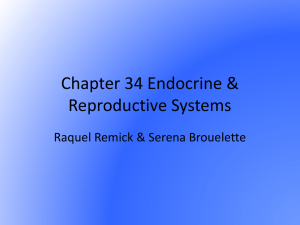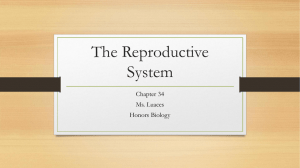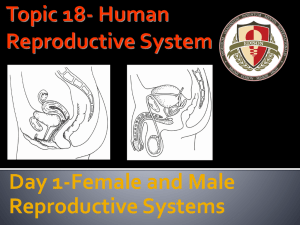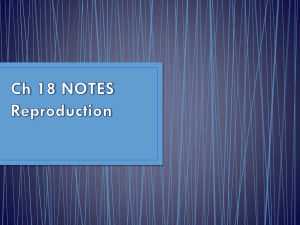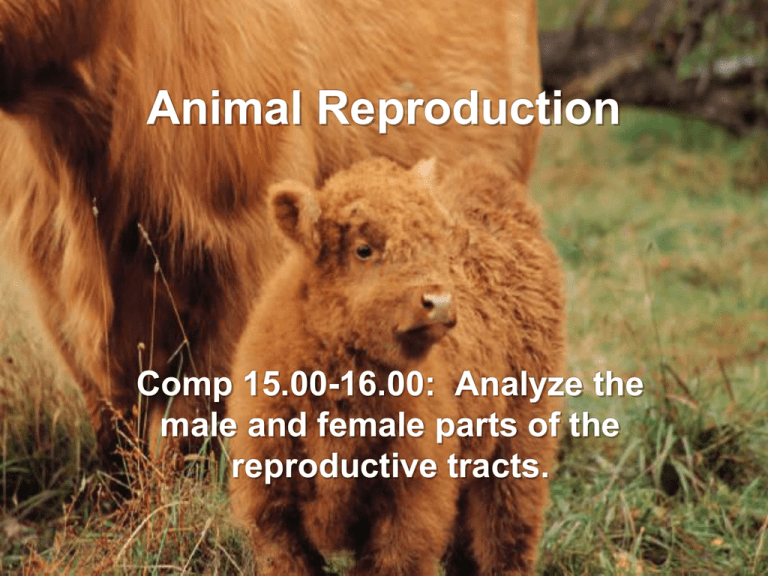
Animal Reproduction
Comp 15.00-16.00: Analyze the
male and female parts of the
reproductive tracts.
Animal Reproduction
• Reproduction
– The process by which animals produce
offspring for the purpose of continuing a
species
– The process begins with…
• The mating of a male and a female of a species
• This is called copulation
http://x59.xanga.com/3d1c976b37733208128098/w162040574.jpg
Animal Reproduction
• During copulation
– Sperm cells (Spermatazoa) are transferred
from the male reproductive tract to the female
reproductive tract
– In the female reproductive tract, the sperm
unite with the egg cell (ovum) to form an
embryo.
• The embryo attaches to the uterus where it receives
nourishment, and develops until the new offspring is
delivered from the female reproductive tract in a
process called parturition
Male Macrostructure and Function
• Male Reproductive System
– Major Function
• The production, storage, and deposition of sperm
cells
• Also functions by production male sex hormones
and serves as a passageway for expelling urine
from the urinary bladder
Male Macrostructure and Function
• Testes
– Paired, ovoid shaped organs that produce
sperm cells and the male sex hormone
testosterone
• Testosterone causes the development of
secondary male characteristics and sex
behavior/drive (libido)
http://www.mfgroup.co.za/gallery1/galleries/Martinco%20Boerdery/large_cow.jpg
Male Macrostructure and Function
• Scrotum
– Protects and supports the
testes
• The wall of the scrotum
raises or lowers the tests to
maintain a constant
testicular temperature of
approximately 4-6 degrees
below body temperature,
because sperm must
develop under conditions
cooler than the body.
Male Macrostructure and Function
• Epididymis
– Coiled tube connected to each testis and is
responsible for the maturation, storage, and
transportation of sperm cells.
– The deferent duct (vas deferens) originates
from the epididymis and serves as a
passageway for sperm to the urethra
http://www.genetics.unibe.ch/content/rubrik/cattle/e2353/e3035/index_eng.html
Male Macrostructure and Function
• Accessory glands
– Responsible for the production of secretions
that contribute to the liquid non-cellular
portion of semen, known as the seminal
plasma
Male Macrostructure and Function
• Vesicular glands (seminal vesicles)
– Paired accessory glands that secrete seminal
fluid that adds fructose and citric acid to
nourish the sperm and functions as a
protection and transportation medium for
sperm upon ejaculation
• Ejaculation
– Discharge of semen from the penis
Male Macrostructure and Function
• Prostate Gland
– Secretes a thick, milky fluid that mixes with
the seminal fluid and provides nutrition and
substance to the ejaculation.
• Cowper’s Gland (bulbourethral gland)
– Secrete a fluid similar to the seminal fluid,
cleanses and neutralizes the urethra form
urine residue that can kill sperm cells.
Male Macrostructure and Function
• The Penis
– The organ that allows for deposition of semen
into the female reproductive tract.
– The sheath
• The external portion of the male reproductive tract
that serves to protect the penis form injury and
infection
http://www.longhornroundup.com/wp-content/uploads/2009/02/sheath-and-testiculs-1-300x200.jpg
Male Microstructure and Function
• Spermatogenesis
– Is a process of cell division and maturations
that begins with stationary cells called
spermatogonium and ends with motile
spermatozoa
http://science.tjc.edu/images/reproduction/spermatogenesis.jpg
Male Microstructure and Function
• Seminiferous Tubules
– Are tubular structures that coil through the
testes.
– The process of spermatogenesis takes place
within the seminiferous tubules.
Male Microstructure and Function
• Interstitial Cells
– Between the seminiferous tubules are groups
of interstitial cells (cells of Leydig) that
function in the production of the male sex
hormone, testosterone.
Male Microstructure and Function
• Testosterone
– Is an androgen hormone that directs the
development of masculine traits
– A constant level of androgens, especially
testosterone, has a major influence on an
animal’s libido, as well as spermatogenesis
Female Macrostructure and
Function
• The purpose of the female reproductive
system
– Is to produce the eggs (ova) to be fertilized by
the sperm
– Also serves as a receptacle for the penis
during copulation
– Houses and nourishes the fetus until
parturition
Female Macrostructure and
Function
• Ovaries
– Two ovaries function to produce eggs and the
female hormones, estrogen and progesterone
• Oviducts (fallopian tubes)
– Are the paired tubes that transport the eggs form
the ovaries to the uterus
• Two funnel-like opening called infundibulums
– Pick up the eggs at ovulation and direct them to the oviducts
• The oviduct is the site where the sperm and th ova meet
and where fertilization occurs
Female Macrostructure and
Function
• Uterus
– The uterus consists of a body and horns
• The embryo attaches to the uterine body, or to the
wall of the uterine horn, depending on the species
of the animal
– Functions as the passageway for sperm
during copulation
– Incubates the embryo during pregnancy, and
contacts to expel the fetus during parturition
Female Macrostructure and
Function
• Vagina
– The vagina serves as the receptacle for the
penis during copulation and as the birth canal
during parturition
• The uterus is separated form the vagina by the
cervix
• The cervix serves as a passageway for the semen
from the vagina to the uterus at copulation
Female Macrostructure and
Function
• Vulva
– Is the external portion of the female
reproductive tract that serves to protect the
internal system from infection, to initially
receive the penis at copulation, and to act as
a passageway for urine.
Female Microstructure and
Function
• Just as the male testes produce sperm cells, the
female ovaries produce ova in the process
called oogenesis
– The development of the ova begins before the female
is even born
– Cells called oogonia develop in the ovaries of a fetus
– By the time of birth, these oogonia have matured into
oocytes. There are thousands of oocytes at the time
of birth; however, only a small portion of these
develop into ova or reach ovulation
Female Microstructure and
Function
• Follicle
– The process of oogenesis occurs within a
follicle. Either on a continual cycle or
seasonally, females of different livestock
species will produce ova through the process
of oogenesis.
Female Microstructure and
Function
• Corpus Luteum
– After ovulation, the ruptured
follicle collapses and a small
hemorrhage occurs
• this blood-clotted area is called a
corpus hemorrhagicum and only
lasts two to three days
• This area begins to be filled by a
yellow mass of cells. This yellow
body is called the corpus luteum.
– Its cells have the primary
purpose of producing the female
sex hormone, progesterone
Female Microstructure and
Function
• The process of oogenesis is a part of the
estrous cycle
– This cycle includes estrus, a period in which a
female shows outward signs of receptivity to
breeding as a result of the hormones
secreted, also referred to as “heat”
http://i.pbase.com/g6/93/702193/2/71994051.PD4VlJCk.jpg
Structure of the Male Reproductive
System in Poultry
• The male reproductive anatomy of poultry
differs when compared to that of other
animal species
– The poultry anatomy consists of two testes
(each with an epididymis and vas deferens)
that lead to papillae and a rudimentary
copulatory organ
• Rudimentary Copulatory Organ
– An underdeveloped sex organ such as is found in male
poultry
http://www.mwt.net/~hobbyfarm/chicken/21chicks.jpg
Structure of the Male Reproductive
System in Poultry
• The testes are unique in
that they are located along
the backbone within the
abdominal cavity
• The cloaca is the portion of
the lower end of the avian
digestive tract that provides
a passageway for products
of the urinary, digestive,
and reproductive tracts
Structure of the Male Reproductive
System in Poultry
• The copulatory anatomy
consists of two papillae
and the rudimentary
copulatory organ
– The papillae are located
at the end of the vas
deferens and on the floor
of the cloaca
– During copulation, the
sperm is passed from the
papillae into the oviduct
opening or cloacal wall of
the female
Structure of the Male Reproductive
System in Poultry
• Androgen is the male
sex hormone
produces by the
testes
– It not only directs
sexual activity and the
production of sperm,
but it also controls
secondary sexual
characteristics of the
male including:
growth, crowing or
gobbling, and strutting
Structure of the Female
Reproductive System in Poultry
• The female of most animal species has two
functional ovaries
– Mature female poultry have only one functional
ovary
• The functional parts consist of an ovary, an oviduct,
and the cloaca.
• The ovary appears as a cluster of tiny, gray balls
that are oocytes
• At maturity, the ovary contains up to 4,000 tiny
oocytes from which yolks or ova (ovum) may
develop over time.
Structure of the Female
Reproductive System in Poultry
• Each oocyte is enclosed in a thin sac
called the follicle and is attached to the
ovary by a vascular stalk.
– When the yolk is mature it is released form
the follicle and then engulfed by the funnellike infundibulum
http://animalsciences.missouri.edu/reprod/Notes/poultry/Image93.jpg
Structure of the Female
Reproductive System in Poultry
• The yolk
– Enters a coiled oviduct that is about 25 inches
long and consists of five clearly define parts
• The first part is the infundibulum. The
infundibulum functions in receiving the yolk and is
the site of fertilization
• The second part is the magnum that secretes the
thick white or albumen
• The third, the isthmus adds the two shell
membranes
Structure of the Female
Reproductive System in Poultry
• The fourth, the uterus secretes the thin white, the
shell, and the shell pigment.
• Last, is the vagina that holds the egg until it is laid
– The egg passes from the oviduct to the cloaca and then
out of the body through the vent at the time of laying
The Formation of an Egg:
•
The Yolk: The chicken egg starts as an egg yolk inside a hen. A yolk (called an oocyte at this point) is produced
by the hen's ovary in a process called ovulation. The yolk is the food for the developing embryo
•
Fertilization: The yolk is released into the oviduct (a long, spiraling tube in the hen's reproductive system), where
it can be fertilized internally (inside the hen) by a sperm.
•
The Egg White (albumin): The yolk continues down the oviduct (whether or not it is fertilized) and is covered with
a membrane (called the vitelline membrane), structural fibers, and layers of albumin (the egg white). This part of
the oviduct is called the magnus.
•
The Chalazae: As the egg goes down through the oviduct, it is continually rotating within the spiraling tube. This
movement twists the structural fibers (called the chalazae), which form rope-like strands that anchor the yolk in the
thick egg white. There are two chalazae anchoring each yolk, on opposite ends of the egg.
•
The Eggshell: The eggshell is deposited around the egg in the lower part of the oviduct of the hen, just before it is
laid. The shell is made of calcite, a crystalline form of calcium carbonate. This entire trip through the oviduct takes
about one day.
•
Growth of the Embryo: The fertilized blastodisc (now called the blastoderm) grows and becomes the embryo. As
the embryo grows, its primary food source is the yolk. Waste products (like urea) collect in a sack called the
allantois. The exchange of oxygen and carbon dioxide gas occurs through the eggshell; the chorion lines the
inside surface of the egg and is connected to the blood vessels of the embryo.
•
The Incubation Period: The embryo develops inside the egg for 21 days (the incubation period), until a chick
pecks its way out of its eggshell and is hatched.
Structure of the Female
Reproductive System in Poultry
• Estrogen is the female sex hormone
– In poultry estrogen stimulates the growth of
the oviduct and causes the cloaca to increase
in size during egg laying
• It also modifies the feather shape and
pigmentation of the female
• Estrogen increases the level of fat, phosphorus,
and calcium in the blood, as this is necessary in
egg production

